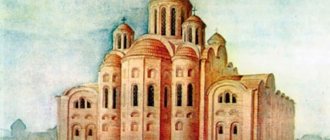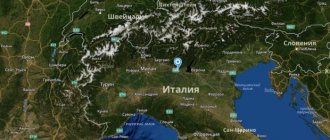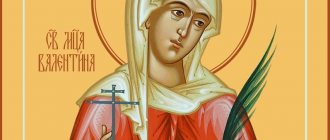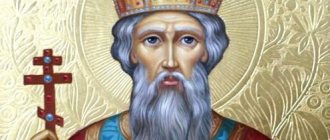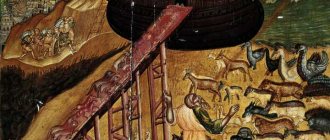The Story of the Saint
Who is this Equal-to-the-Apostles Saint, in whose honor the monastery of Saint Thekla , known to everyone in Cyprus and being the most “popular” shrine for pilgrims? It is known from only one source: the Acts of Paul and Thecla, an early Christian work of literature written in the 2nd century AD.
Thekla was born at the beginning of the 1st century in Iconium, the capital of the ancient state of Asia Minor, Lacaonia. Her parents were of noble origin and were reputed to be rich. Already from childhood, Thekla was a very pretty girl, and in her youth she was an amazing beauty. At the age of 18, her parents betrothed her to the noble young man Thamirid.
One day Thekla attended a city sermon by St. Paul about the Savior. The heart of the young beauty was filled with reverent love for Jesus Christ, and she decided to take a vow of celibacy, refusing to marry Thamirid. The wounded and offended young man could not come to terms with the “strange” choice of his betrothed. On the advice of his friends, Thamirid went to the ruler of the city and accused the Apostle Paul of “forbidding virgins to marry.”
Saint Paul was imprisoned. But Thekla, it turns out, visited the apostle, bribing the jailers with her jewelry. She could no longer do without Paul’s instructions and his stories about the Savior. Her parents became aware of her secret “meetings”.
The disobedient daughter and the Apostle Paul were brought to court. The Apostle was sentenced to be scourged and expelled from the city. Thekla, who answered all the questions of the judges with meek silence, her own mother wished to “burn” at the city fire, as an edification to those virgins and wives who do not want to obey their parents’ word and accept the laws of the city and country.
Thekla Iconium
Thecla of Iconium I – II centuries.
Memorial Days: September 24/October 7
The name of Saint Thekla of Iconium is not known to all Christian believers. Despite this, thousands of pilgrims come to her relics, which are located in a temple on the island of Cyprus, every year. She is considered one of the patrons of marriage and family life, and is also the first martyr, because she was the first of the Christians to suffer for the Christian faith, and equal to the apostles, because she converted many pagans to Christ.
We can learn about the life of the saint from the only source - the apocrypha “The Acts of Paul and Thecla.”
Saint Thekla was born in the 1st century in the city of Iconium. The girl's parents were from a noble and wealthy family. She received a good education and at the age of eighteen was engaged to a young man named Thamirid. The girl had a kind disposition and extraordinary beauty, so the groom was looking forward to the wedding day. Thekla herself also dreamed of a future family life, until an amazing event happened: the Apostle Paul came to the city, bringing people the teaching about Jesus Christ.
Living next to the temple, the girl accidentally heard the sermon of St. Paul, which impressed Thekla so much that she decided to completely change her life: “... and listened day and night to the word of God, proclaimed through Paul, both about purity, and about faith in Christ, and about prayer; and she did not leave the window, but was filled with rejoicing in faith...”
Thekla was so imbued with the preaching of the Apostle Paul that she decided to give up marriage and devote her life to serving God. Thamirid and Thekla's family were angry. The would-be groom turned to the city ruler with a complaint against the Apostle Paul: “We do not know where this little man came from, who forbids virgins to marry; Let him himself tell you in front of you what kind of self-interest he is teaching this.”
Paul's answer was not heard and it was decided to throw the saint into prison. Even after this, the girl could not be convinced to change her decision. Thekla was unshakable. At night, she bribed the guards by giving away her jewelry and entered the prison of the Apostle Paul.
The next day, the family found Thekla in prison. She strengthened her faith even more and also insisted on her decision not to marry. Then the mother, enraged by her daughter’s decision, demanded that the ruler of the city execute the rebellious Thekla, so that the other girls of Iconium would not dare to disobey their relatives.
The ruler did not want to execute the girl, but the crowd and Thekla’s relatives stubbornly insisted. After much deliberation, it was decided to expel the Apostle Paul from the city, and sentence the disobedient Thekla to be burned at the stake. Perhaps Saint Thekla’s relatives hoped that she would renounce her faith, but this did not happen. Having climbed onto the fire, the girl did not feel the heat of the fire. Thekla’s faith saved her, God had mercy on the saint and sent heavy rain from heaven. The fire gradually died out, and Thekla was saved.
Seeing the miraculous salvation, people fled, fearing the wrath of God. Saint Thekla left her hometown and went in search of the Apostle Paul. One of Saint Paul’s companions met the girl and took her to the apostle, saying: “Come here, and I will take you to him!” For he has been groaning for you, and praying, and has been fasting for six days.” Thekla decided to cut off her girlish braids and go with Pavel. The saint, together with the apostle, brought the Word of God to the city of Antioch.
New troubles awaited Thekla. In Antioch, the local governor Alexander fell in love with the girl, who could not resist her beauty. Having failed to achieve reciprocity, out of resentment he slandered the saint before the abbot of the city - the hegemon of Antioch. Since the time was very difficult for righteous people, the ruler of the city decided to execute Thekla and condemned her to death. It was decided to give the saint to be torn to pieces by wild animals. Thekla was thrown to the wild lioness: “And Thekla sat down in an elevated place, and the lioness lay down at her feet, and all the people marveled at it.”
Even after this, the city residents did not calm down and decided to continue their atrocities. On the second day, they threw the holy girl to be torn to pieces by hungry lions and bears. The lioness protected Thekla and killed the bear. Then they released the angry lion. At the cost of her life, the lioness again protected the saint. After this, the hegemon ordered poisonous creatures to be released on Thekla, but prayer protected the saint from them.
For the third time, the hegemon tried to execute Thekla - he tied her to two bulls, and they began to drive them in different directions with hot rods so that they would tear the saint apart. But this time too, the Lord protected Thekla - the strong ropes broke and the bulls ran away. “And the women all exclaimed with a great voice, and as if with one mouth they gave praise to God, saying: “There is only one God who saved Thekla!” And the whole city shook at the sound of their rejoicing.” After this, the ruler of the city, frightened by the miracles he had seen, decided to release Saint Thekla. “And the hegemon immediately announced his decree, saying: “I release Thekla, the pious servant of God, to you.”
With the blessing of the Apostle Paul, Saint Thekla settled in the desert surroundings of Seleucia of Isauria (now the city of Silifke in Turkey) and lived there for many years, constantly preaching the Word of God and healing the sick with prayer. Saint Thekla converted many pagans to Christ. She even punished the pagan priest who encroached on her purity for his insolence and brought him to holy Baptism. More than once the enemy of the human race tried to destroy Saint Thekla through people blinded by sin, but the power of God always preserved the faithful servant of Christ.
When Saint Thekla was already a 90-year-old old woman, the pagan magicians took up arms against her because she treated the sick for free. They could not believe that the saint healed illnesses with the power of the grace of Christ, and believed that she was especially protected by the goddess Artemis. Out of envy of Saint Thekla, they sent mercenaries to her to desecrate the saint. When the pursuers were already very close, Saint Thekla begged for help to Christ the Savior, and the mountain parted, hiding the holy righteous woman. Thus Saint Thekla gave up her soul to the Lord.
In Rus', the saint has long been revered, but until recently there were no churches in honor of her in our country. On August 28, 2021, on the day of the celebration of the Dormition of the Blessed Virgin Mary, the grand opening of the Assumption Feklina women's hermitage monastery took place in the Kozel diocese. In this monastery, the first church in Russia was consecrated in honor of the holy Equal-to-the-Apostles First Martyr Thekla.
By God's providence, part of the relics was found by Christians and transported to one of the islands closest to Syria - Cyprus. Today these relics are kept in the convent of St. Thekla, located in a picturesque mountain valley among olive trees on the outskirts of the village of Mosfiloti, near the city of Larnaca.
The monastery, believed to have appeared here in 1471, received the name of St. Thekla, and in 1991 it became a refuge for women nuns. In the 18th century, a church was built in the monastery, an iconostasis was created, and the title icon of the temple was painted - the icon of St. Thekla, dressed in a beautiful silver frame already in the 19th century.
The soil taken from the miraculous spring on the territory of the monastery is famous for healing believers from skin diseases. No matter what storms rage in the world, the monastery - a haven of godlike humility - will stand unshakably, purifying our souls, showing us the path to spiritual achievement.
Prayer to Saint Thecla of Iconium
Having learned the teachings of the Apostle Paul, Thekla, who was ignorant of God, and strengthened by faith from the Apostle Peter, the divinely called one, you became the first martyr and the first victim among the women, you entered the fire, as into a flower garden, the animals and young men were afraid of you, for you armed yourself with the Cross. Therefore, pray to Christ God, glorified by all, for the salvation of our souls.
Servant of God
And sentenced to be burned, she was led to the prepared scaffold. But the girl, without a shadow of fear, ascended the fire: the Savior appeared to her and blessed the unfortunate woman for the upcoming feat. When the flames of the fire ignited, the sky suddenly darkened, and a heavy downpour began, filling a terrible fire. Everyone fled in fear, and Thekla went home from her hometown.
She found Saint Paul and went with him to Antioch, a city in ancient Syria. The ruler of the city, Alexander, was captivated by Thekla’s beauty and showed her signs of attention. However, the beauty angrily rejected his claims and tore the robe from Alexander’s shoulders, and at the same time the wreath from his head, and tore them in front of the astonished ruler. For such insolence, Thekla was sent to be torn to pieces by wild beasts. However, the predators behaved in a strange way: the wild lioness rushed to the girl’s defense, tearing the hungry bear to shreds and attacking the huge lion.
The Iconian maiden remained safe and sound this time too. Alexander then realized that Thekla was not a simple girl, but was under the protection of God himself, and therefore the fire did not take her and the hungry animals would not touch her. They released her.
Guardians of the Holy Relic
The monastery is located not far from Larnaca, in the vicinity of the village of Mosfiloti. The picturesque valley is surrounded on all sides by gentle green hills. The monastery of Saint Thekla lies in it, like in a precious emerald bowl, framed by olive and fig groves.
The first written mention of the monastery dates back to 1780. At first, the monastery was for men and quite sparsely populated, despite its impressive land holdings. The formation of a monastery around a small temple presumably dates back to the second half of the 15th century.
The temple is a single-nave basilica, built in the traditional ascetic style of that time. The main temple icon, located to the right of the iconostasis, dates back to the 18th century. Her rich silver frame was made later. As a sign of limited access, the icon is covered with a crimson curtain with gold embroidery. The idea of building the church belonged to Equal-to-the-Apostles Helen, the mother of the Byzantine Emperor Constantine, who made a significant contribution to the spread of the Christian faith.
At the beginning of the 18th century, the monastery shared the fate of the entire rural population of the island: the years of Turkish rule were a time of decline and real poverty. But the spark of enlightenment and the Orthodox faith did not fade away under the ashes of the fires of Christian churches, and church life continued through the labors of a few, sometimes illiterate, ascetic priests who served the liturgy from memory. At the turn of the 19th and 20th centuries, a school was located in the monastery premises, in which approximately fifty children from nearby villages studied.
Since 1956, with the blessing of Archbishop Macarius III, at that time the head of the autocephalous Cypriot Orthodox Church, services resumed in the monastery, new inhabitants began to appear in it: surviving monks came from the monasteries destroyed by Turkish fanatics.
Prayers heal
And Thekla again began to look for the Apostle Paul, and found him. He taught the girl that she needed to preach the word of God. The pilgrim returned to Iconium, forgave her mother and converted her to Christianity . And she began to preach her faith, and a healing gift was revealed in her. Thekla healed sick people and children with the power of prayer.
She settled in the vicinity of Seleucia, a city in ancient Syria. She lived for almost 90 years. According to church tradition, Thekla was persecuted by pagan sorcerers because she unselfishly treated the sick and suffering. She escaped from them in the mountains, in a cave. There the Servant of God reposed, finding eternal peace.
Her relics were found in a cave on Mount Kalamon, not far from the village of Maaloula (Syria). The relics were kept in the city of Tarsus - in Cilician Armenia. But after Armenia was captured by the Mamluks, part of the saint’s relics were transported to Cyprus, where they are kept to this day in a convent named after Saint Thekla.
Zhen glory
Already by the ancient Orthodox Church, Thekla, “the mentor of the sufferers, who opened the torment of the path for everyone,” was numbered among the first martyrs. In Cyprus, Saint Thekla has a special attitude: she is considered the holy intercessor and prayer book for women, Thekla’s name is mentioned when they are tonsured into monasticism.
Thekla's homeland is the Asian Minor city of Iconium in the territory of modern Turkey. Today this city is called Konya. The meeting with the Apostle Paul, who was performing missionary service, became fateful for young Thekla: she decided to turn her gaze to heaven and devote her life to serving God. The seed of God's word fell on fertile soil, sprouted and took root firmly in the heart of the godly girl. The Apostle Paul encouraged her to learn the word of God and even considered her his “first spiritual daughter.”
Thekla begged the Almighty for her healing gift. For a long time she preached in her hometown, converting many people to Christianity, including her own mother, a hard-hearted and proud woman, an ardent champion of paganism. Then she chose the Syrian city of Seleucia to live, where she ended her days, living to the age of ninety.
Russian people believed in omens, beliefs, on the day of Thekla the Spinner
Signs and sayings for the holiday of Thekla Zarevnitsa
- If there are a lot of acorns, the winter will be warm and the summer will be fruitful.
- The early dawn on October 7 and the bright sun signal a quick change in the weather.
- If a squirrel sheds its tail, the winter will be very cold.
- If there is thunder, it means that the winter will be short and warm.
- No matter what the weather is like in Zimobor (April 7), so is Thekla the harnesser.
- On Thekla the nights are dark and the day is waning. Even if the barn burns, you feed the threshers.
- Stoke the barns - drown them, but look back at Thekla.
- The first threshing was on Thekla, the second on Pokrov.
- The day is waning and running away no longer with chicken steps, but with horse steps; the nights become darker and darker, the dawns become more and more crimson.
- The first barn is called the birthday boy.
- Gerard sometimes gives hope that a second summer will come with him.
- The leaves have turned yellow by this day, but are falling slightly - frosts will not come soon.
- Until the leaves fall from the cherries, no matter how much snow falls, the thaw will drive it away.
- South-east wind at constant atmospheric pressure - there will be no precipitation for at least several days.
Icon of Saint Thekla
On the icons, Saint Thekla is depicted as a beautiful girl of a noble family, but very thin, in shabby clothes. In her hands she holds a scroll with the inscription: “Heavenly God, mighty God, generous God, for to Him is the kingdom of heaven forever and ever.” Another version of the inscription is “A virgin who preserves her virginity for the sake of Christ: to have a share with the Angels is Christ’s bride. Christ is her Bridegroom, lead me into His heavenly palace.”
Third prayer to Saint Equal-to-the-Apostles Thekla
“O blessed holy first martyr, virgin equal to the apostles, the most praiseworthy Theklo, the true bride of Christ, the beauty of the firmament of the church, the mental morning star of Heaven, the holy bead of purity and chastity, the fragrant blossom of the garden of Eden! You, who loved the very life of the only Lord more than all the good things, who suffered well for His Name, who was wondrously crowned by Him with the crowns of virginity, martyrdom and apostleship, who were included in the face of Heaven, even though you now rejoice in eternal glory, but did not abandon us who honor you, as a vigilant intercessor and merciful intercessor before God. And since your Bridegroom, sweetest Jesus, has given you the great grace, we humbly pray to you: heed the request of our hearts, do not leave us orphans in this world; visit us in the prison of existing sin, quickly raise us to vigorous repentance, teach our souls and bodies to maintain purity, direct us to the path of good deeds, inhale zeal towards the Gospel, infuse prayers with holy fire and lead us to Divine love. She, the kindly victorious first sufferer, since you can ask for many benefits from the Most Merciful Jesus our Savior, be a quick helper in this life. Intercede for us with angelic protection, heal the wounds and ulcers of the sick, send down grace-filled joy to those who mourn, protect youth and adolescence with purity, assist monks in labor and obedience, preserve indissoluble marriage, create invincible warriors in battles, and squander the enemies of the faith and the Holy Church. Christ, your prayer for us to the Lord, may He grant us a blameless course of life, a painless, comfortable, peaceful old age; I am not ashamed of the death, the Mysteries of the Most Holy, the Body and Blood of His Divine, I am a partaker, in the Kingdom of Heaven for us to abide there with the angels, and together with the saints to sing in the Trinity of the glorified God, the Father, and the Son, and the Holy Spirit , to endless ages of ages. Amen."
Troparion, tone 4
Having learned the words of Pavlov, God-blessed Theklo, and having been strengthened by faith from Peter, the divinely called first martyr appeared and the first sufferer among women: you ascended into the flames, as if into a prosperous place, the animals and youths were afraid of you, armed with the cross. Thus pray, O all-validated Christ God, that our souls may be saved.
Kontakion, tone 8
You shone with the kindness of virginity, and you were adorned with the crown of martyrdom, entrusting yourself to the apostleship as a glorious virgin; and you turned the flame into dew, and you tamed the youth’s rage with your prayer, as if you were the first to suffer.
In Kontakion, voice 2
Having wounded your virtuous heart, with the love of Christ, you overthrew the temporary betrothed as if you were careless and dared to risk the fire; You stopped the mouths of the beasts, and having saved yourself from them, you diligently sought Paul, the first-suffering Theklo.
Greatness
We magnify you, passion-bearer of Christ, Equal-to-the-Apostles Theklo, and honor your illnesses and labors, in the image in which you worked in the gospel of Christ.
In glorification
We magnify you, passion-bearer of Christ, Equal-to-the-Apostles Theklo, / and honor your honest suffering, which you have endured for Christ.
New life for old walls
Already in 1991, the appearance in Mosfiloti of two sisters, nuns Eulogia and Constantia, marked the beginning of the revival of the monastery as a convent. Currently, Constantia is the abbess of the monastery, which has seven nuns.
In the old days, the monastery was built around an early Christian cave church, the remains of which can still be seen today. It is located on the site of one of the miraculous springs. Thus, the place from which the water flows is located exactly under the altar of the temple. The aquifer mixed with clay inclusions and formed a viscous substance that has the healing properties of water. This healing clay (or mud) has long been used to treat skin diseases. Access to the well is provided from outside the temple. The level of clay rises and falls from time to time, but it is always within reach.
The second source is perfectly equipped on the territory of the monastery compound. The mosaic panels decorating it depict birds and animals drinking the precious moisture. But the main miracle of the monastery is the reverently preserved parts of the relics of St. Thekla. Everyone who had the honor of kissing them notes their amazing warmth.
Monastery on the map and GPS coordinates
How to get to the monastery? Location: Mosfiloti village. Nearby there is a highway to Nicosia, along which the distance to the capital is 22 kilometers. The nearest resort centers are Larnaca (22 kilometers), Limassol (44 kilometers).
From Larnaca you need to leave in a western direction, from Limassol - in an eastern direction. The route from Larnaca starts from highway B4 to A3. Having reached the ring where B3-B5-A3-A5 converge, you need to turn left and follow the A5 highway. The next turn is at the intersection with B1, where you need to turn and get to the sign for the village of Mosfiloti.
From Paphos and Limassol the traffic is clear: follow A1 until it intersects with B1, and then follow to the village sign.
From Ayia Napa and Protaras, follow the highway towards Larnaca, where you repeat the route.
GPS parking at the monastery walls: 34.947360 33.421400.
In Cyprus there is a temple of the same name: the Church of St. Thekla Ayia Napa. A small, beautiful structure, recently built next to the cave chapel, is located on the shore of the bay. The church is visited by local residents; it is not included in the list of attractions.
Territory of beauty
The monastery courtyard is a well-groomed territory divided into zones, very similar to the courtyard of a large rich villa. Flower beds arranged with love and care, lush crowns of trees, a courtyard paved with stone, climbing plants and palm trees in huge clay pots - everything bears the imprint of the care and tireless work of the nuns of the monastery. Canopies, gazebos, and galleries entwined with vines are amazingly beautiful and provide shelter from the hot sun.
The cell monastery buildings that can be seen today date back to the end of the 18th century. The tranquil courtyard is framed by covered two-tier galleries of residential premises. Unfortunately, most of them are still empty. Despite this, absolutely all buildings are maintained in exemplary order.
The monastery buildings are designed in the same style - the same wooden trim, metal door fittings - and form a cozy harmonious ensemble.
The memory of the great Orthodox saint is carefully revered in all corners of the island, so the monastery of St. Thekla is well known to every Cypriot. The memory takes place on September 24 and becomes a real patronal holiday, the guests of which are thousands of pilgrims.
Everyone who comes to the monastery with an open, repentant heart leaves it comforted, with a feeling of peace and grace. The incredible silence that reigns in this place of spiritual power encourages you to listen to your conscience, cleanse your soul and thoughts, and help you find humility and peace of mind.

